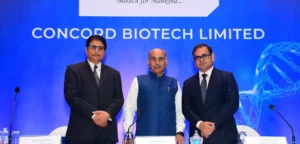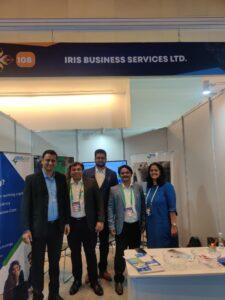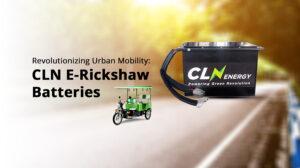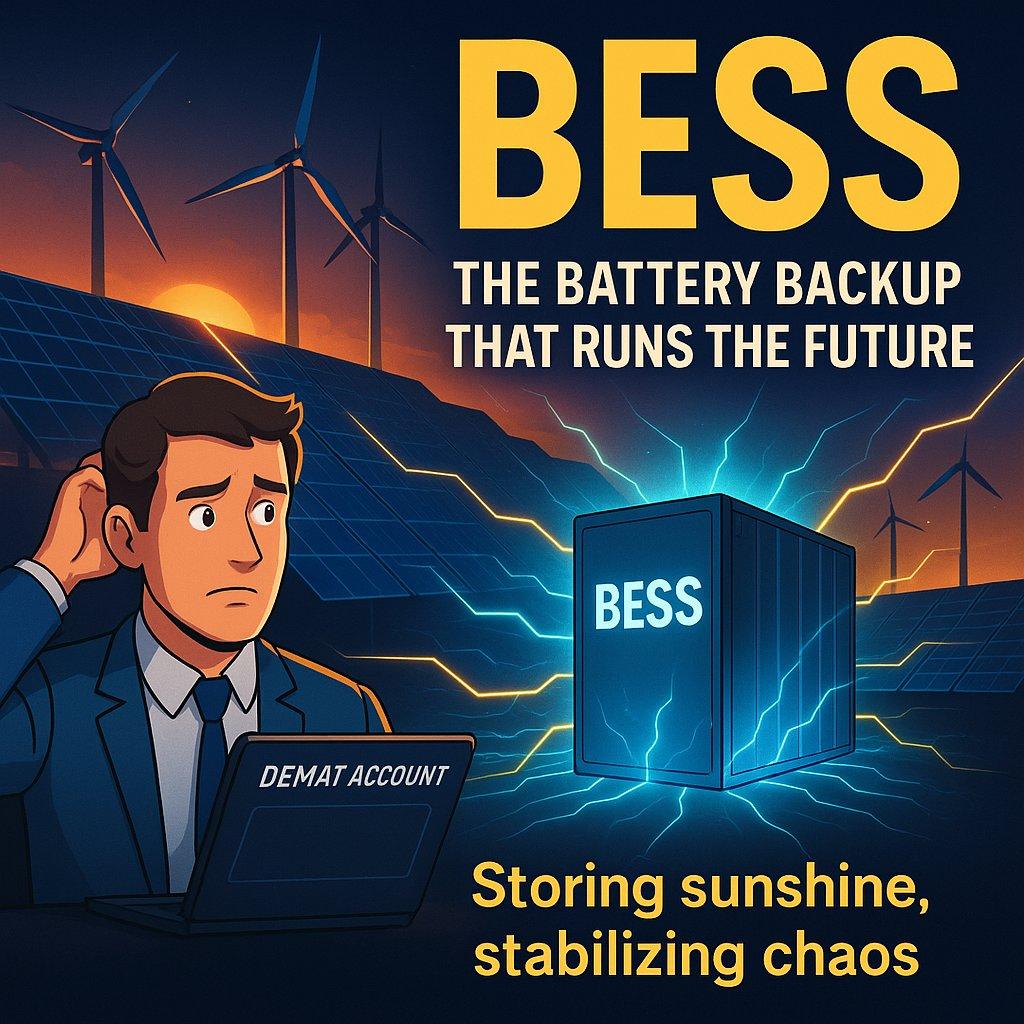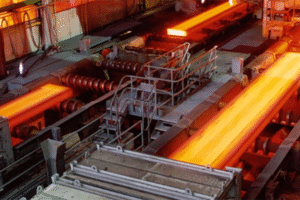1. 🧠 At a Glance
Battery Energy Storage Systems (BESS) are the silent workhorses powering the renewable energy revolution. They charge when power is cheap, discharge when it matters, and stabilize the grid when it’s about to have a nervous breakdown. From solving the “sun only shines during the day” problem to replacing diesel guzzlers in villages, BESS is a clean energy essential. But hey, they’re not magic. They’re expensive, need minerals controlled by China, and can catch fire if not babysat.
2. 🎯 Introduction with Hook
Imagine installing ₹500 crore worth of solar panels—and watching them produce zero when you need power most. Welcome to the renewable energy problem. Now imagine a giant box quietly charging when the sun’s blazing and heroically stepping in when the sun dips. That box is a BESS. This is not just a tech gimmick—it’s the bridge between green ambition and grid reality. But before you romanticize batteries too much, let’s open the lid.
3. 🏭 Business Model (WTF Do They Even Do?)
BESS is essentially the UPS of the grid—but bigger, smarter, and ten times more expensive.
They:
- Store surplus electricity (usually from solar/wind).
- Discharge during peak hours, grid failures, or blackouts.
- Provide grid services (frequency regulation, voltage support).
- Replace fossil fuel peaker plants.
- Enable rural microgrids in power-starved areas.
Revenue comes from:
- Arbitrage (buy low, sell high).
- Capacity payments.
- Ancillary grid services.
- Avoided capex on diesel or coal backup.
Operators? Think Tata Power, Fluence, Tesla, ReNew Power, and even Adani (because of course).
4. 📊 Financials Overview – Profit, Margins, ROE, Growth
Let’s not kid ourselves: BESS isn’t a margin machine yet. Most projects are:
- Capex-heavy (₹4–6 crore per MWh).
- Low on recurring opex (after setup).
- Long payback (6–10 years).
But the market is exploding:
- India: Expected 38 GW / 152 GWh by 2030.
- Global TAM: >$400 billion by 2040.
- Lithium-ion battery costs: Down 85% since 2010.
- Major players like Tesla report >25% gross margins on Megapacks.
For now, profits are project-specific. The ROI gets juicy only if:
- Battery prices drop further,
- Solar and wind curtailment becomes more common,
- Regulations allow monetizing services like “frequency response”.
5. 💸 Valuation – Is It Cheap, Meh, or Crack?
Valuation = tricky.
For now:
- Most BESS projects are embedded inside energy companies.
- Pure-play BESS firms (e.g. Fluence, Powin, Stem Inc.) trade at 5–10x sales, not EBITDA.
- Indian firms like Tata Power, Adani Green, and ReNew Power are BESS-adjacent—not pure plays.
So far, valuations are forward-looking AF, built on:
- Subsidy assumptions.
- Storage mandates.
- ESG-friendly capital flows.
Fair Value Range (project-based IRR logic):
- Assuming ₹5.5 Cr/MWh capex, 18% IRR, 20-year life: returns only make sense if grid arbitrage spreads widen and regulations allow 2–3 stacked revenue streams.
Translation: Don’t expect a bargain bin multiple on this space anytime soon.
6. 🍳 What’s Cooking – News, Triggers, Drama
- India’s big push: MNRE storage tenders, PLI schemes, and solar-wind-battery hybrid mandates.
- South Asia’s largest BESS in Delhi (20 MW / 40 MWh) went live this year.
- Modhera Village (Gujarat) runs entirely on solar + BESS.
- Reliance entering BESS via its New Energy vertical (wait for JioMegapack?).
- Fires in California (Moss Landing) raise valid safety concerns.
- Hydrogen vs BESS debate is heating up—policy will choose the winner.
Trigger to watch: If CERC mandates storage capacity for all renewable PPAs, expect chaos (and opportunity).
7. 🧾 Balance Sheet – How Much Debt, How Many Dreams?
BESS projects are asset-heavy, so expect:
- 60–80% debt financing.
- Typical loan tenures: 8–10 years.
- Cash flows front-loaded via service payments, arbitrage revenues.
Key risks:
- Interest rate sensitivity is high.
- If grid regulations change (or fail to support ancillary services), debt coverage ratios take a hit.
- Raw material inflation (lithium, cobalt) can blow up project budgets.
Mitigation? Government-backed green bonds and blended finance are cushioning the blow.
8. 💵 Cash Flow – Sab Number Game Hai
BESS cash flows are lumpy but predictable if contracted.
Structure:
- Revenue from long-term PPAs or capacity contracts.
- Arbitrage-based revenues are volatile (depends on grid pricing dynamics).
- Ancillary service payments are stable but not huge.
Biggest swing factor? Battery replacement cost (every 8–10 years) and degradation (which impacts usable energy over time).
Early-year cash flows look sweet. Later years? Need careful lifecycle modeling.
9. 🧮 Ratios – Sexy or Stressy?
| Metric | Typical Range | Verdict |
|---|---|---|
| ROE | 8–12% (project IRR) | Meh (Needs subsidies) |
| O&M Cost/MWh | ₹2–3 lakh/year | Low, but rising |
| Debt/Equity | 2.5x–4x | Stressy |
| Useful Life | 10–15 years | Okayish |
| Efficiency | 85–92% (round trip) | Sexy |
| Cost Decline | ~10% YoY | Very Sexy |
It’s a numbers game. Early adopters are absorbing teething issues—profits come only after scale and policy support.
10. 📈 P&L Breakdown – Show Me the Money
A typical 100 MWh BESS project P&L (simplified):
- Revenue:
- Grid arbitrage: ₹40 Cr/year
- Ancillary services: ₹10 Cr
- Total: ₹50 Cr
- Expenses:
- O&M: ₹3 Cr
- Interest: ₹12 Cr
- Depreciation: ₹8 Cr
- Battery replacements: ₹5 Cr/year avg
- EBITDA: ₹37 Cr
- PAT (after tax, battery loss, interest): ₹8–12 Cr
- Net Margin: 15–20% on stable contracts, near-zero on merchant projects
It’s a feast if you’re contracted. Otherwise, hope the spot market treats you well.
11. 🥊 Peer Comparison – Who Else in the Game?
| Company | BESS Focus | Market Cap | Comments |
|---|---|---|---|
| Fluence Energy (US) | Pure-play | ~$3.5B | Global leader, profitable on some SKUs |
| Tesla | Partial (Megapack) | $700B+ | Megapack backlog >$10B |
| Tata Power | Emerging | ₹1.3L Cr | Multiple BESS pilots, solar + storage |
| ReNew Power | Moderate | ₹27,000 Cr | Hybrid plants with BESS under dev |
| Adani Green | Moderate | ₹2.8L Cr | Claims largest hybrid RE+BESS pipeline |
| Reliance New Energy | TBD | N/A | Lithium-ion plans under dev in Jamnagar |
India’s still cooking its pure-play BESS IPO. Until then, pick your proxy from the solar/battery manufacturing gang.
12. 🧑💼 Miscellaneous – Shareholding, Promoters
Since most BESS projects are part of larger entities:
- Tata Power: ~46% held by Tata Sons.
- Adani Green: 56% by Gautam Bhai.
- ReNew Power: Listed via SPAC, public float high, promoter holding ~25%.
- Fluence: Joint venture between Siemens and AES.
- Tesla: No explanation needed. Elon is your promoter.
Also note:
- India’s PLI scheme for Advanced Chemistry Cells is bringing new players into battery manufacturing (e.g. Amara Raja, Exide, Reliance).
13. 🧑⚖️ EduInvesting Verdict™
“You can’t transition to a clean energy future without storing sunshine in a box.”
BESS is the invisible duct tape holding the renewable dream together. Without it, solar and wind are glorified guesses. With it, the grid breathes easier. But that doesn’t mean investors should throw caution to the wind (pun intended). This is a tech-heavy, capex-driven, policy-dependent space—perfect for patient capital, not FOMO bulls.
The verdict?
BESS is the future. But the money will be made by those who know when to plug in—and when to stay unplugged.
✍️ Written by Prashant | 📅 July 10, 2025

